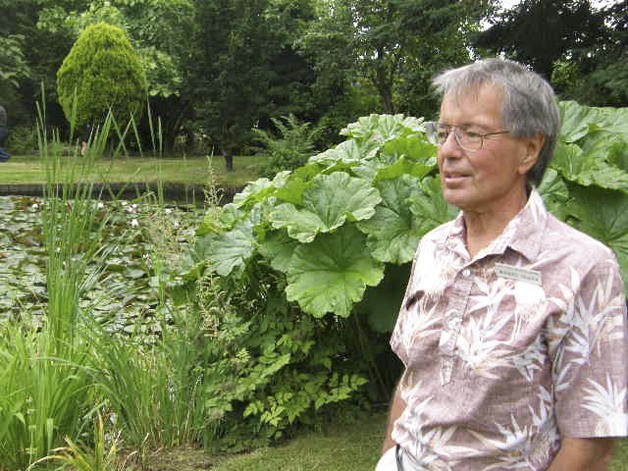Along the paths and greenways connecting the strolling gardens they went, alone, in pairs and by small groups as a soft summer rain splashed gently on leaf and twig and flower.
Through pockets of intoxicating floral fragrances they passed, inhaling scents of daphnes and sarcacosas and roses so powerful they could whip the head around.
Among the partakers was Renton’s Helen Cross, marveling as she strolled through the entry garden, past the house and the banana tree, into the lushness of purple clematis, crocosmia, day lilies, ladies mantle, flowering Inula and thousands of other plants.
“So big and bold,” Cross said, pausing for a moment to appreciate one of her favorites, the broad-leafed Gunnera, a stone’s throw from a giant pond sporting flowering water lillies and ducks.
“They’ve done a magnificent job,” Cross said of the men mainly responsible for the 22-acre Soos Creek Botanical Garden, property owners Morris Skagen and his business partner and friend, James Daly. Last weekend the two pulled the curtain back and invited the world to look at what they have wrought at 29308 132nd Ave. SE, Auburn.
Decades in the developmental stages, and well worth the wait, said James Graves, co-owner of the Old Goat Farm in Graham.
“It’s a beautiful garden,” said Graves as he walked along, adding only that he didn’t envy those who have to keep the 22 acres in top shape.
Surprises abound, among them an aviary attached to the house, a treat for the eye and ear, withsoft cooing doves and brightly colored Asian pheasants, peafowl and chickens.
“People are looking for that sense of nature in a garden setting because of development that has occured in this area,” Skagen explained.
Skagen, 74, a retired Tacoma Community College librarian, began with a much humbler garden in mind in 1965, on the land that his great grandparents first bought in the 1890s, and which his parents passed on to him.

“I started to plant as a homeowner would do, but some trips to England and Japan made me think that maybe I could develop it into more than that, into a stroll garden where people could wander through and see various plants. But as you can see, it sort of grew more and more,” Skagen said with a wry smile.
Indeed, over the decades Skagen collected thousands of plants. But the men were concerned that the property might be swallowed up by growth.
An independent work group called TWIGS (Task Workforce for Integrated Ground Support), 25 people strong, stepped in two years ago, offering to the cause a veritable army of worker bees.
TWIGS encouraged Skagen and Daly to pursue 501-C3 tax status, which they got in January. The men then created a non-profit foundation that controls the garden but allows them to continue to live in their home for the rest of their days.
They turned the day-to-day management over to TWIGS, which designs builds, propagates and maintains the garden.
“It’s like a dream to become part of this,” said TWIGS member Judy Alvau, propagation manager for the Soos Creek Botanical Garden. “The diversity of the plant material here is so incredible, and they treat us so well. They have such a great vision, and it’s such a gift to the community, to get such an established garden that’s already beautiful and with all kinds of amenities that other places just starting out don’t have.”
“It’s breathtaking, because I didn’t grow up where it is green,” said Linda Denny, a West Texas native and a TWIGS member. “The property just goes on and on, winding all the way back to Soos Creek. Morris has put so many years into this. It’s amazing what he’s done. It’s so beautiful.”
Ultimately, Skagen said, the final stage of the stage of the garden is as a nature preserve. Among other features is a future vegetable demonstration area, now well underway.
“One of the things from our demonstration vegetable garden is that the vegetables grown will be given to the Auburn Food Bank. We’re so excited to share that produce. We’re going to have art classes and art in the garden. We’re so excited about the future. This is just the opening weekend, the first time this has become a public garden,” said TWIGS member Barbara Nagle of Maple Valley.
Regular hours are 10 a.m. to 2 p.m., Wednesdays and Thursdays, or by appointment. Docent tours are available to groups.
The Soos Creek History Center, displaying early photos, historical maps and newspaper articles, is part of the complex, devoted to the farming life of the early settlers on the Soos Creek plateau, a 35-square-mile area.
For more information, call 253-639-0949, email sooscreekbotanicalgarden@gmail.com, or check out SoosCreekBotanicalGarden.org.
=====
New summer hours at Soos Creek Botanical Garden and History Center: 10 a.m.-3 p.m., Wednesday-Saturday. These are days when volunteers are present. As the docent program develops, visitors may take self-guided tours of the 22 acres, with a map in hand. There is no charge to stroll the gardens, but donations are gladly accepted. No pets or food are allowed on the property.


